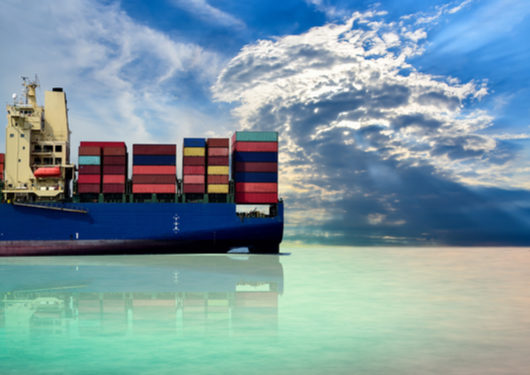
The World Trade Organization’s latest release of its World Trade Outlook Indicator shows merchandise trade volume experiencing above-average growth in early 2018. “Strong results for air freight, container shipping and export orders in particular suggest that, while the trade recovery may moderate in due course, it will likely continue in the coming months and remain above trend,” the report says.
Container shipping volumes in December of 2017 were 5 percent higher than in the same month of 2016, noted Yin Ming, deputy secretary general of the Shanghai International Shipping Institute and professor at Shanghai Maritime University. He presented his outlook for container shipping to the TPM Annual Conference in Long Beach, Calif., sponsored by IHS Markit.
Carrier services have stabilized as well. The game of musical ships that container lines have been playing over the last couple of decades appears to have settled into three major space-sharing pacts: the Ocean Alliance, THE Alliance and 2M Alliance. Together they account for more than 80 percent of the global container trade, and 90 percent of capacity on major routes.
Nevertheless, said Yin, there are factors that could disrupt the current strong performance of the economy at large, and ocean carriers in particular. They include the possibility of a wide-scale trade war, triggered by President Trump’s recent imposition of tariffs on imported steel and aluminum.
Also a question mark is the chronic overcapacity of container slots on major routes, caused by the introduction of giant new ships by every significant carrier in the trades. Even a wider Panama Canal can’t accommodate the largest ships on the water, some with capacity exceeding 20,000 twenty-foot equivalent units (TEUs). Many ports lack the facilities and water depth to handle these behemoths, and those that can are subject to periodic congestion caused by the offloading of thousands of containers at a time. Similar bottlenecks at inland points threaten to slow the movement of cargo and choke off growth.
Yin described 2018 as “a year of recovery and mild adjustment,” while citing Nobel Memorial Prize-winning economist Richard Thaler’s observations about the limits of rationality as a factor in human decision-making. One could argue that the past actions of container lines, with their obsessive focus on capacity and market share at the expense of profitability, validate Thaler’s worldview.
Peter Sand, chief shipping analyst with the Baltic & International Maritime Council (BIMCO), was similarly bullish on ocean shipping’s prospects in 2018, although he told the TPM conference that the year won’t look much different than 2017 in terms of market fundamentals.
“We’re getting only potentially slightly improved positive change to the overall market balance,” Sand said. “It may or may not deliver slightly higher rates.” In fact, the progressive introduction of bigger ships, and resulting overcapacity in key trades, has helped to frustrate carriers’ repeated attempts at boosting freight rates in prior years.
Sand said global economic growth is likely to continue, with limits. “We see a strong market of demand, but nothing compared to a year ago, with double-digit growth in supply and also demand. We are on a tighter leash.”
Ocean carriers suffered through a terrible 2016, “bleeding money on a daily basis,” Sand said. But when markets improve, shipowners tend not to get rid of surplus capacity. Big ships displaced by even bigger ships simply “cascade” into smaller trades, where they cause further disruption and make it even harder for lines to shore up sagging freight rates.
“In 2018, the key is how much capacity will be demolished,” said Sand. “If we’re going to see higher freight rates, we’ll need demand growth to outstrip supply growth.”
Graham Slack, chief economist with the Maersk Group, said 2017 was the best year for container shipping since 2011, with carriers racking up growth of 5.6 percent. They enjoyed the fruits of a rebound in gross domestic product and trade across all regions. Even a slowdown of growth in the fourth quarter wasn’t enough to offset an overall expansion for the year.
The outlook for 2018 and beyond remains positive, Slack said. Global export orders continue “very strong.” And capital spending — the missing component of growth for the past six to eight years — is bouncing back, driving forecasts of 4-5 percent growth in global trade for 2018 and 2019. “It’s a pretty robust outlook from most forecasters,” he said.
The overcapacity problem is easing up, at least for the moment. Last year saw demand for container services outstripping supply by a factor of nearly three, “the first time this has happened for many years,” Slack said. And while supply and demand have yet to achieve balance, the results of 2017 were a considerable improvement for carriers over the prior two years. What’s more, the global orderbook for new ships stands at half the level of 2012-2015.
Carriers nevertheless have work to do. The bankruptcy of Hanjin Shipping Co., Ltd. in early 2017 exposed the industry’s underlying fragility. Carriers, said Slack, are focusing too much on freight rates and too little on service. Shippers are carrying excess inventory because they can’t trust service providers to deliver the goods in a timely fashion that meets the demands of the modern-day consumer. Meanwhile, carriers still aren’t earning their cost of capital on a consistent basis.
The tension between cost and service is putting carriers in a bind, even as they reap the benefits of a strong economy. They could quickly return to their old ways of flooding the trades with capacity to lock up market share.
“Customers are turning to their suppliers and asking us to do more with less,” said Slack. “This is the main opportunity and challenge facing the industry today. We’re not delivering a good enough product to the customer.”







